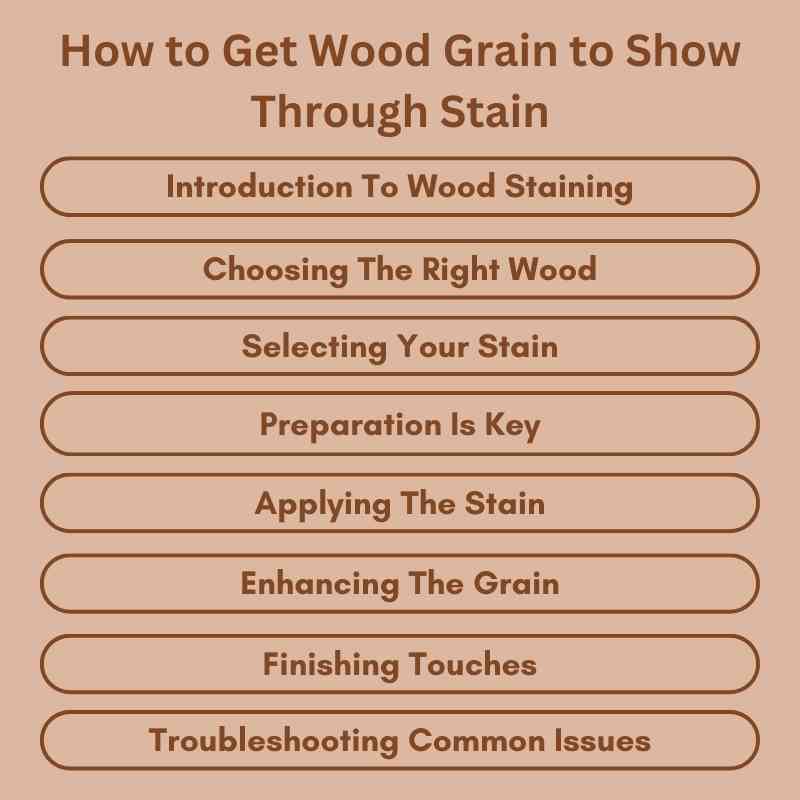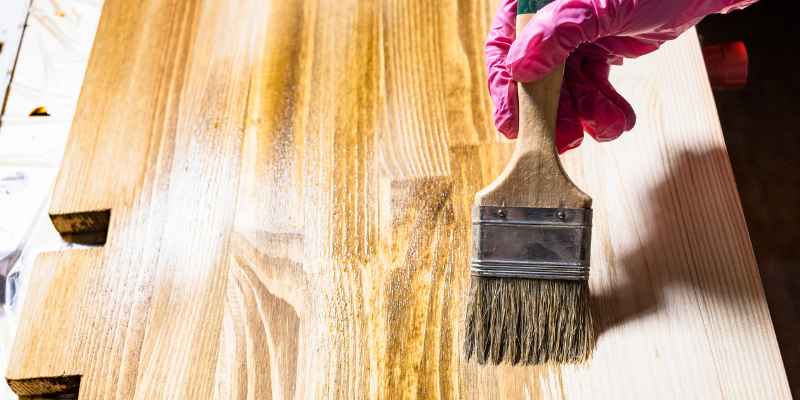To get wood grain to show through stain, start with a wood conditioner to prepare the surface. Choose a lighter stain color for optimal visibility of the grain.
Achieving a beautiful wood grain finish enhances the natural beauty of your woodworking projects. The right stain application can highlight intricate patterns while adding depth to the wood. Many DIY enthusiasts aim for this effect, whether for furniture, cabinetry, or decorative pieces.
Understanding the techniques for showcasing wood grain is essential for achieving professional-looking results. This guide will provide you with step-by-step instructions and tips to ensure your wood retains its character while benefiting from a rich, vibrant stain. Get ready to transform your wood surfaces into stunning focal points!
Introduction To Wood Staining
Wood staining highlights the natural beauty of wood grains. Many people love the unique patterns that each piece of wood offers. Staining brings out these patterns beautifully. It enhances the color and texture of the wood. The right stain can transform a plain piece into something stunning.
Choosing a stain that complements the wood type is important. For example, lighter stains show off the grain more than darker ones. Using a pre-stain conditioner can help too. This product helps the wood absorb the stain evenly. It prevents blotchiness and enhances the overall look.
Test the stain on a small area first. This helps to see how the wood reacts. Experimenting with different stains can lead to amazing results. The goal is to make the wood grain stand out while keeping its natural charm.

Choosing The Right Wood
Choosing the right wood is crucial for showing off the grain. Some types of wood have better grains than others. Here are some great options:
- Oak: Known for its deep, prominent grain.
- Maple: Offers a subtle, smooth grain that can be enhanced.
- Cherry: Features a rich, warm color with a fine grain.
- Pine: A budget-friendly choice with a unique, rustic look.
Properly prepping wood is key to achieving the best results. Start by sanding the surface smooth. Use a fine-grit sandpaper for a polished finish. Clean the wood thoroughly to remove dust. This ensures the stain adheres well and highlights the grain.
Selecting Your Stain
Selecting the right stain is very important for your project. Oil-based stains are thicker and provide a rich color. They often enhance the wood grain beautifully. Water-based stains dry faster and clean up easily. They have less odor and are safer to use.
Color is another vital factor. Choose a shade that matches your wood type. Lighter stains show more of the wood’s natural patterns. Darker stains can hide some grain details but offer a bold look.
Transparency also matters. Transparent stains let the wood grain shine through clearly. Semi-transparent stains provide some color but still highlight the grain. Solid stains cover the grain almost completely.
Preparation Is Key
To show wood grain through stain, start with a clean surface. Remove all dirt and dust. Use a damp cloth to wipe the wood. Make sure it is completely dry before moving on.
Sanding is essential for a smooth finish. Use sandpaper with a fine grit. Sand in the direction of the grain. This helps the stain soak in better. After sanding, clean the surface again to remove any dust.
Applying The Stain
To get the best wood grain look, gather the right tools. You will need:
| Tool | Purpose |
|---|---|
| Sandpaper | Prepares the wood surface |
| Stain brush | Applies the stain evenly |
| Rags | Wipes off excess stain |
| Protective gloves | Keeps your hands clean |
For an even application, use a brush or a lint-free cloth. Start at one end and work your way across. Apply the stain in thin layers. This helps to show the wood grain better. Allow the stain to penetrate for a few minutes. Wipe off any excess stain with a clean rag. Repeat these steps until the desired color is achieved.
Enhancing The Grain
Wet sanding helps bring out the depth of wood grain. Use fine sandpaper to gently smooth the surface. This technique opens up the pores, allowing the stain to penetrate better. Always wet the sandpaper slightly to avoid scratching.
Grain fillers can also enhance the wood’s appearance. They fill in the gaps, making the grain stand out more. Choose a filler that matches the wood type. Apply it with a putty knife, then wipe off excess. Let it dry before applying stain.
Finishing Touches
Sealing the wood helps protect the grain. Choose a high-quality sealant for the best results. Apply a thin, even layer using a brush or cloth. Allow the sealant to dry completely before adding any stain.
Regular maintenance keeps the wood looking great. Wipe the surface with a damp cloth to remove dust. Avoid using harsh chemicals that can damage the finish. Reapply sealant every few years for optimal protection.
| Maintenance Tip | Frequency |
|---|---|
| Wipe with damp cloth | Monthly |
| Reapply sealant | Every 2-3 years |
Troubleshooting Common Issues
Stain not penetrating can be frustrating. This often happens due to a few reasons. One reason is the wood being too dry. Another is using a stain that is too thick. To fix this, try applying a pre-stain conditioner. This helps the wood absorb the stain better.
Uneven color and patchiness can ruin the look of your project. This issue may arise from applying too much stain in one area. To avoid patchiness, use a clean cloth to wipe off excess stain. Always apply the stain evenly, following the wood grain.

Frequently Asked Questions
How Do I Prepare Wood For Staining?
To prepare wood for staining, start by sanding the surface. Use fine-grit sandpaper for a smooth finish. Clean off any dust or debris before applying the stain. Pre-conditioning the wood with a wood conditioner can also help achieve an even stain application, enhancing the wood grain visibility.
What Type Of Stain Shows Wood Grain Best?
Oil-based stains are typically best for showcasing wood grain. They penetrate deeper into the wood and provide a rich color. Water-based stains can also work, but they may require more effort to achieve a similar effect. Always test on a scrap piece first to see which stain you prefer.
How Can I Enhance Wood Grain After Staining?
To enhance wood grain after staining, consider applying a clear topcoat. Polyurethane or varnish can add depth and shine. Additionally, using a glaze can accentuate the grain further. Make sure the stain is completely dry before applying any topcoat for the best results.
Can I Stain Over Painted Wood To Show Grain?
Staining over painted wood is challenging and not always effective. If the paint is opaque, it will block the grain visibility. To achieve a natural look, you should strip the paint first. Once the wood is bare, you can apply stain to reveal the beautiful grain beneath.
Conclusion
Achieving a beautiful wood grain finish is within your reach. By following the right techniques, you can enhance the natural beauty of your wood surfaces. Remember to choose the right stain, apply it correctly, and finish with care. With practice, your projects will showcase stunning wood grain that impresses.
Happy staining!

